The AMD 2nd Gen Ryzen Deep Dive: The 2700X, 2700, 2600X, and 2600 Tested
by Ian Cutress on April 19, 2018 9:00 AM ESTCPU Rendering Tests
Rendering tests are a long-time favorite of reviewers and benchmarkers, as the code used by rendering packages is usually highly optimized to squeeze every little bit of performance out. Sometimes rendering programs end up being heavily memory dependent as well - when you have that many threads flying about with a ton of data, having low latency memory can be key to everything. Here we take a few of the usual rendering packages under Windows 10, as well as a few new interesting benchmarks.
All of our benchmark results can also be found in our benchmark engine, Bench.
Corona 1.3: link
Corona is a standalone package designed to assist software like 3ds Max and Maya with photorealism via ray tracing. It's simple - shoot rays, get pixels. OK, it's more complicated than that, but the benchmark renders a fixed scene six times and offers results in terms of time and rays per second. The official benchmark tables list user submitted results in terms of time, however I feel rays per second is a better metric (in general, scores where higher is better seem to be easier to explain anyway). Corona likes to pile on the threads, so the results end up being very staggered based on thread count.
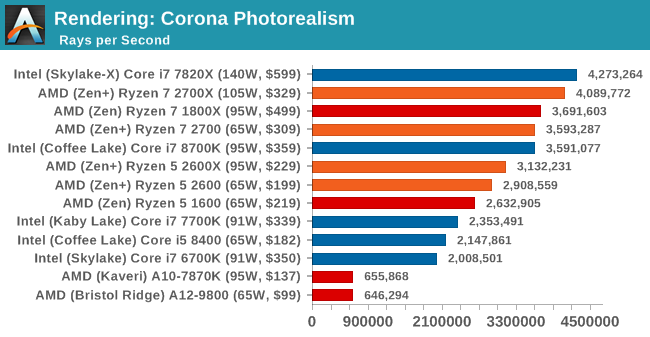
Blender 2.78: link
For a render that has been around for what seems like ages, Blender is still a highly popular tool. We managed to wrap up a standard workload into the February 5 nightly build of Blender and measure the time it takes to render the first frame of the scene. Being one of the bigger open source tools out there, it means both AMD and Intel work actively to help improve the codebase, for better or for worse on their own/each other's microarchitecture.
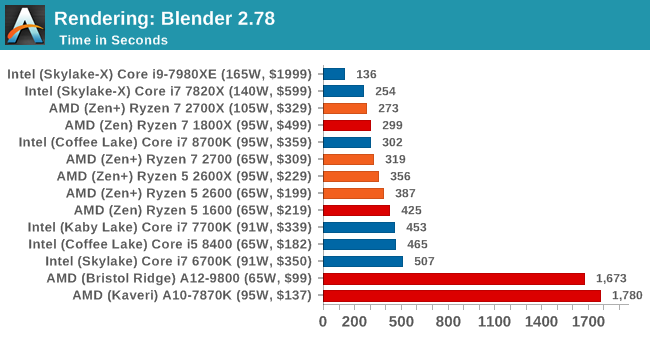
This is one multi-threaded test where the 8-core Skylake-based Intel processor wins against the new AMD Ryzen 7 2700X; the variable threaded nature of Blender means that the mesh architecture and memory bandwidth work well here. On a price/parity comparison, the Ryzen 7 2700X easily takes the win from the top performers. Users with the Core i7-6700K are being easily beaten by the Ryzen 5 2600.
LuxMark v3.1: Link
As a synthetic, LuxMark might come across as somewhat arbitrary as a renderer, given that it's mainly used to test GPUs, but it does offer both an OpenCL and a standard C++ mode. In this instance, aside from seeing the comparison in each coding mode for cores and IPC, we also get to see the difference in performance moving from a C++ based code-stack to an OpenCL one with a CPU as the main host.

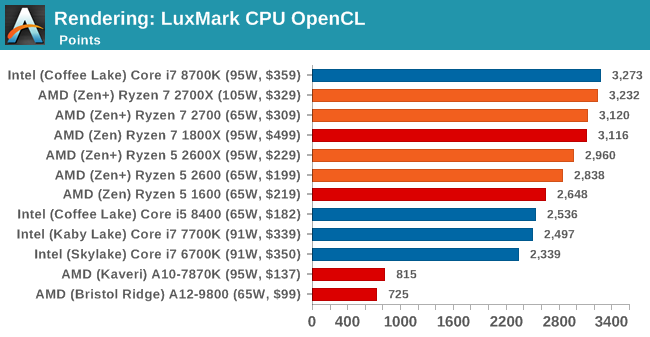
POV-Ray 3.7.1b4: link
Another regular benchmark in most suites, POV-Ray is another ray-tracer but has been around for many years. It just so happens that during the run up to AMD's Ryzen launch, the code base started to get active again with developers making changes to the code and pushing out updates. Our version and benchmarking started just before that was happening, but given time we will see where the POV-Ray code ends up and adjust in due course.
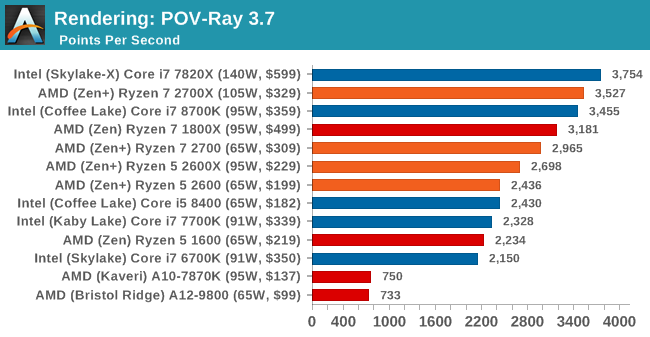
Cinebench R15: link
The latest version of CineBench has also become one of those 'used everywhere' benchmarks, particularly as an indicator of single thread performance. High IPC and high frequency gives performance in ST, whereas having good scaling and many cores is where the MT test wins out.
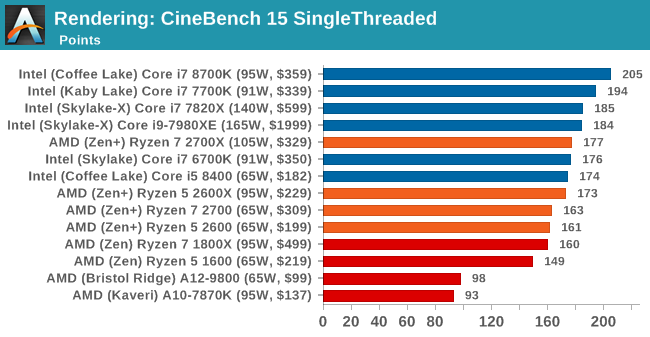
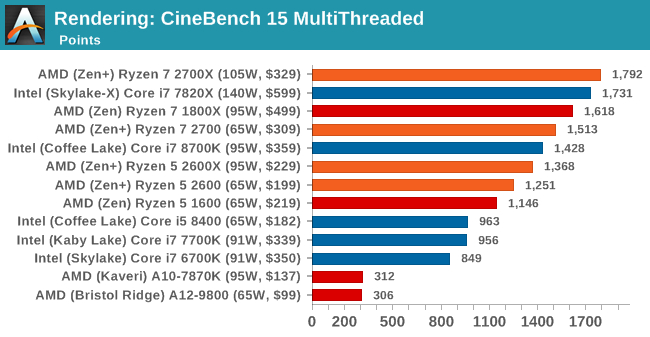
Intel is still the single thread champion in benchmarks like CineBench, but it would appear that the Ryzen 7 2700X is now taking the lead in the multithreaded test.










545 Comments
View All Comments
YukaKun - Saturday, April 21, 2018 - link
Oh, I'm actually curious about your experience with all the systems.I'm still running my i7 2700K at ~4.6Ghz. I do agree I haven't felt that it's a ~2012 CPU and it does everything pretty damn well still, but I'd like to know if you have noticed a difference between the new AMD and your Sandy Bridge. Same for when you assemble the 2700X.
I'm trying to find an excuse to get the 2700X, but I just can't find one, haha.
Cheers!
Luckz - Monday, April 23, 2018 - link
The the once in a lifetime chance to largely keep your CPU name (2700K => 2700X) should be all the excuse you need.YukaKun - Monday, April 23, 2018 - link
That is so incredibly superficial and dumb... I love it!Cheers!
mapesdhs - Monday, April 23, 2018 - link
YukaKun, your 2700K is only at 4.6? Deary me, should be 5.0 and proud, doable with just a basic TRUE and one fan. 8) For reference btw, a 2700K at 5GHz gives the same threaded performance as a 6700K at stock.And I made a typo in my earlier reply, mentioned the wrong XEON model, should have been the 2680 V2.
YukaKun - Tuesday, April 24, 2018 - link
For daily usage and stability, I found that 4.6Ghz worked best in terms of noise/heat/power ratios.I also did not disable any power saving features, so it does not work unnecessarily when not under heavy load.
I'm using AS5 with a TT Frio (the original one) on top, so it's whisper quiet at 4.6Ghz and I like it like that. When I made it work at 5Ghz, I found I had to have the fans near 100%, so it wasn't something I'd like, TBH.
But, all of this to say: yes, I've done it, but settled with 4.6Ghz.
Cheers!
mapesdhs - Friday, March 29, 2019 - link
(an old thread, but in case someone comes across it...)I use dynamic vcore so I still get the clock/voltage drops when idle. I'm using a Corsair H80 with 2x NDS 120mm PWM, so also quiet even at full load; no need for such OTT cooling to handle the load heat, but using an H80 means one can have low noise aswell. An ironic advantage of the lower thermal density of the older process sizes. Modern CPUs with the same TDP dump it out in a smaller area, making it more difficult to keep cool.
Having said that, I've been recently pondering an upgrade to have much better general idle power draw and a decent bump for threaded performance. Considering a Ryzem 5 2600 or 7 2700, but might wait for Zen2, not sure yet.
moozooh - Sunday, April 22, 2018 - link
No, it might have to do with the fact that the 8350K has 1.5x the cache size and beastly per-thread performance that is also sustained at all times—so it doesn't have to switch from a lower-powered state (which the older CPUs were slower at), nor does it taper off as other cores get loaded, which is most noticeable on the the things Samus mentioned, ie. "boot times, app launches and gaming". Boot times and app launches are both essentially single-thread tasks with no prior context, and gaming is where a CPU upgrade like that will improve worst-case scenarios by at least an order of magnitude, which is really what's most noticeable.For instance, if your monitor is 60Hz and your average framerate is 70, you won't notice the difference between 60 and 70—you will only notice the time spent under 60. Even a mildly overclocked 8350K is still the one of best gaming CPUs for this reason, easily rivaling or outperforming previous-gen Ryzens in most cases and often being on par with the much more expensive 8700K where thread count isn't as important as per-thread performance for responsiveness and eliminating stutters. When pushed to or above 5 GHz, I'm reasonably certain it will still give many of the newer, more expensive chips, a run for their money.
spdragoo - Friday, April 20, 2018 - link
Memory prices? Memory prices are still pretty much the way they've always been:-- faster memory costs (a little) more than slower memory
-- larger memory sticks/kits cost (a little) more than smaller sticks/kits
-- last-gen RAM (DDR3) is (very slightly) cheaper than current-gen RAM (DDR4)
I suppose you can wait 5 billion years for the Sun to fade out, at which point all RAM (or whatever has replaced it by then) will have the same cost ($0...since no one will be around to buy or sell it)...but I don't think you need to worry about that.
Ferrari_Freak - Friday, April 20, 2018 - link
You didn't write anything about price there... All you've said is that relative pricing for things is the same it has always been, and that's no surprise.The $$$ cost of any give stick is more than it was a year or two ago. 2x8gb DDR4-3200 G.Skill Ripjaws V is $180 on Newegg today. It was $80 two years ago. Clearly not the way they've always been...
James5mith - Friday, April 20, 2018 - link
2x16GB Crucial DDR4-2400 SO-DIMM kit.https://www.amazon.com/gp/product/B019FRCV9G/
November 29th 2016 (when I purchased): $172
Current Amazon price for exact same kit: $329